Modern marketing moves fast—everywhere. Marketing in 2025 is reliant on multiple feedback channels, tight deadlines, and conditional approvals. Even if everything goes perfectly throughout your approval process, there are bound to be difficulties streamlining the feedback and materials you need to successfully complete your project or campaign.
One campaign can span social, search, email, events, and influencers, each with specs and shifting priorities. Deadlines compress, launches stack up, and creative approvals crawl as files bounce between chats, inboxes, and scattered folders. Stakeholders want status yesterday; legal and brand want rigor; producers chase versions while designers redo work no one can find. The result: missed handoffs, slipped dates, last-minute fire drills, and fuzzy reporting hiding what’s moving the needle.
That’s where project management software for marketing teams comes into play. Perhaps one of the most critical tools for modern marketers, project management software marries the disparate channels that can exist in a company of any size.
Marketing project management software exists to calm that chaos. Tools can centralize briefs, timelines, assets, and dependencies so every channel works from a single source of truth. Automated workflows route creative for review, proofing tools capture feedback in context, and approval trails keep compliance tight. Resource views balance workloads; templates speed recurring launches; integrations connect your DAM, design tools, and CRM so nothing falls through the cracks.
In this article, we’ll talk about how marketing project management software addresses these common issues, and dig into some tools that can help you. Whether you’re scaling a startup team or coordinating complex campaigns, you’ll learn what to look for—features, use cases, and evaluation tips—and how to get work done faster with fewer surprises.
Why Generic Project Management Tools Fail Marketers
If a tool isn’t built with marketers in mind, feedback loops will be immediately fragmented.
Generic project management tools were built for predictable, linear work—ship a feature, close a ticket, move on. Marketing is none of that. Campaigns sprawl across channels, creative cycles are messy by design, and “done” usually means “approved by five stakeholders and legally safe,” not just “task checked off.” Here’s where generic tools fall short for marketing teams.
Broken Creative Review Cycles
The first shortcoming of some project management tools is that they just don’t handle creative reviews well. Marketers need visual proofing on images, video, and copy with frame-accurate comments, version control, and side-by-side comparisons. A generic “attach file and leave a comment” turns into endless threads, missing context, and duplicate assets. No markup, no approvals, no audit trail—just chaos.
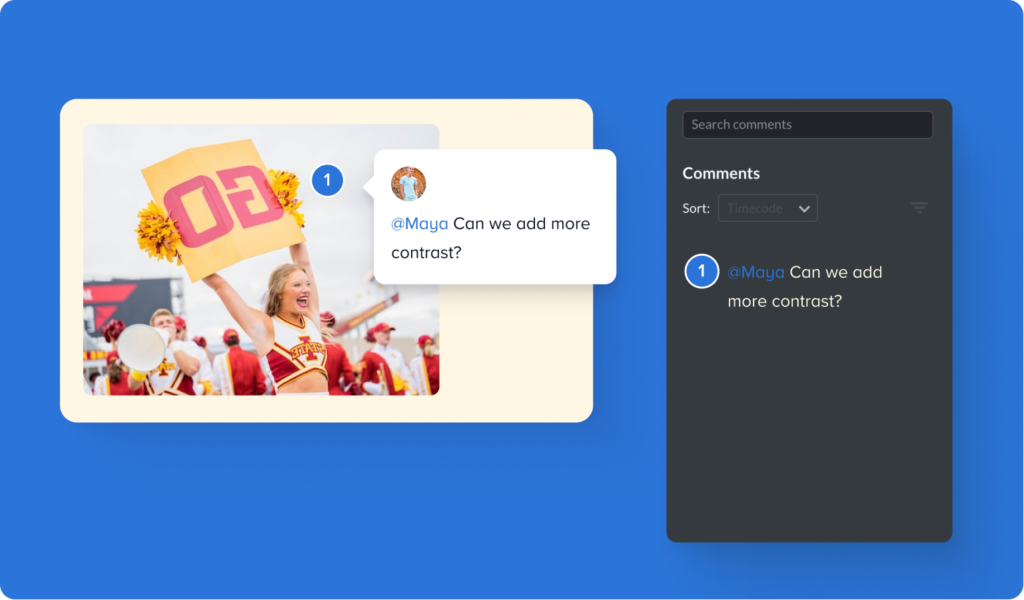
Second, approvals aren’t a single button. Marketing routes work through product, brand, legal, and external partners, often in a specific order with SLAs. Generic tools can’t model multi-stage, conditional approvals or auto-nudge the right reviewer. That’s how launch timelines fall behind and “final_final_v7” is the name of the final asset you send off to your DAM.
Lack of Campaign Calendar
Third, campaign time isn’t task time. Marketers think in calendars: launch windows, embargoes, content cadences, and channel cut-downs. Most PM tools can’t show a true campaign calendar with cross-channel dependencies, blackout dates, and time-zone aware go-lives—so teams rebuild it in spreadsheets (again).
Resource Planning Differences
Fourth, resource planning is different. Creative capacity isn’t interchangeable “hours.” A motion designer, a copy lead, and a media buyer aren’t swappable. The way marketing teams need to understand workload and team capacity are completely different from the way an engineering team would view it.
Additionally, data lives elsewhere. Marketers need integrations with Figma/Adobe, DAMs, CMS, CRM, ad platforms, and social schedulers. When your PM tool can’t pull in briefs, link the latest asset, or sync statuses back to the channel tools, you end up with swivel-chair ops and stale work.
Reporting & Data Tracking
Finally, reporting matters. “Tasks completed” won’t tell you if creative throughput improved, approvals are the bottleneck, or which campaign template ships fastest. Without marketing-specific metrics and roll-up views, teams can’t optimize process or forecast realistic launch dates.
The result? Shadow spreadsheets, scattered assets, missed handoffs, and slow approvals. Marketing project management software fixes this with in-context proofing, multi-stage workflows, true campaign calendars, role-aware resourcing, deep integrations, and reporting built for creative operations.
Key Features That Marketing Teams Need
Project management software is inherently valuable across teams of all types, but for marketing teams specifically, some critical features need to be accounted for.
1. Project or Asset Intake Forms
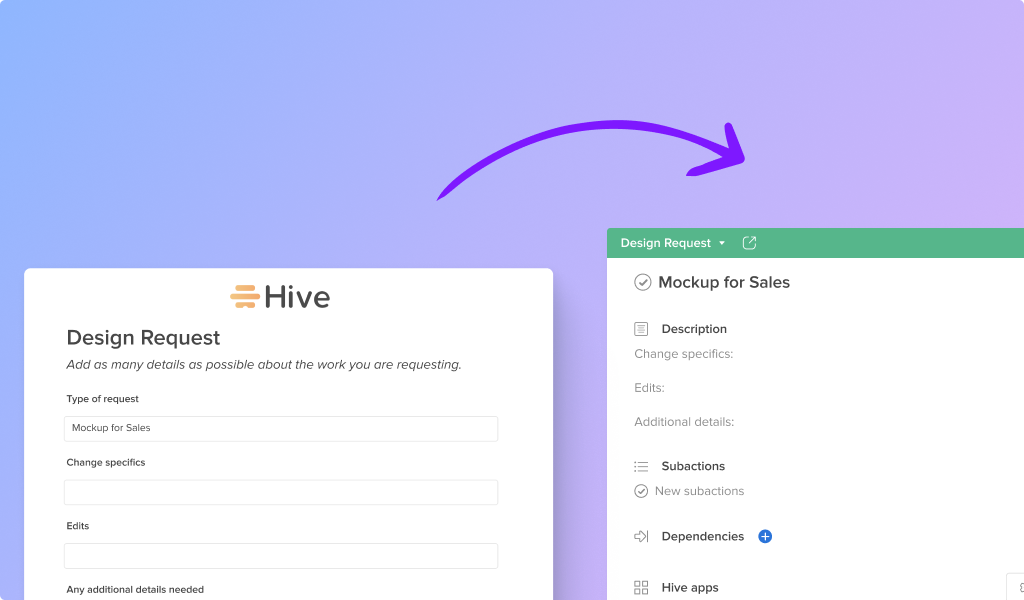
Work comes in to marketings flow in many ways…despite marketers often trying to streamline and create some sort of intake process. Hive Forms are the absolute easiest way to do this.
One single URL can house all of the intake questions, file attachments, and prompts that a team needs to get started on a project or asset without needing 4 different meetings to decide what the actual asset they need is. Once a Form is submitted, the form is directly ported into a project or action, depending on the team’s preference, and assigned out to the first person in the workflow that would need to tackle it.
Even better? Those projects or actions that are created as a result of a Form fill can have a template quick-applied to them. That means that you don’t even need to do any manual work to get the project started – it just starts itself.
2. Proofing & Approvals
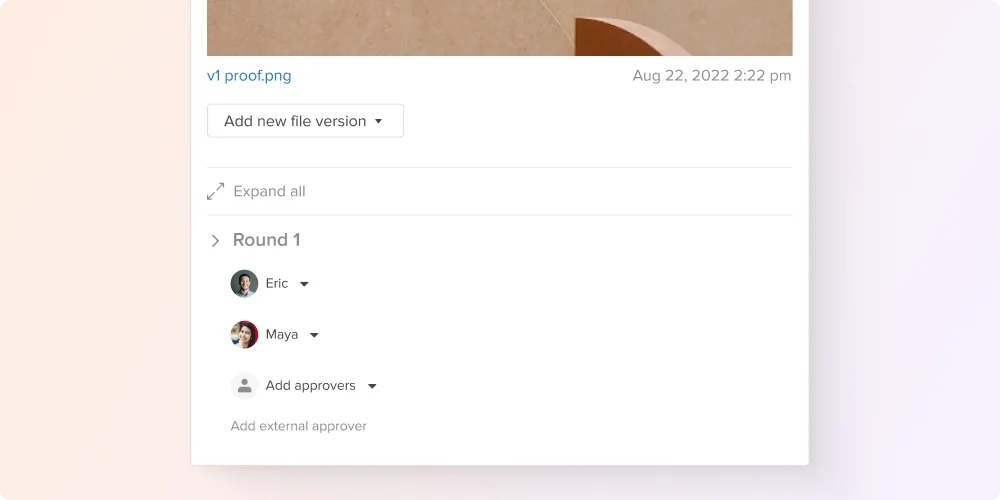
I’m not sure I’ve ever come across a marketing team that doesn’t approve or review files of any type. Whether it’s videos, podcasts, emails, flyers – marketing teams need a place where they can store versions of assets, gather feedback, and clearly understand where the most important assets are in the review cycle.
Something very important that Hive has is Approval Templates – meaning that assets can be uploaded and a saved review and approval cadence can be applied to multiple assets. Once you’ve created the approval template for your team that starts with Operations and ends with the CMO, you can apply that approval flow to as many assets over time as you need.
This repeatable workflow cuts down on any confusion, messy handoffs, missed deadlines, and miscommunication that can happen when one person is approving something in Slack, the other on Teams, and then someone else on email. In Hive, you can see each layer of approval a document has gone through, review the changes that were requested, and ship an item directly to your DAM once it’s good to go.
The trail of approval and the context that provides for teams throughout any stage of the design and marketing process is invaluable.
3. Client Portal
After material comes into Hive as a request or form fill, we typically see people utilize our client portal. This is an easy way for stakeholders to review and understand how their items are progressing, where their feedback is needed, and more.
A client portal acts as a secure, branded environment where external stakeholders can view project progress, access approved assets, and provide feedback—all without digging through inboxes or chasing status updates. This transparency builds trust, reduces “just checking in” emails, and creates a single source of truth for all client-facing communications. For agencies and in-house marketing teams alike, a portal turns client interactions from reactive to proactive.
4. External Users
Involving external parties, whether it’s a freelance creative team, client stakeholders, or individual contributors, is common in marketing workflows and requires a tool that has external user permissions. These people don’t need to be in the project management software day in and day out, but they need to be able to touch base on items.
Giving vendors, freelancers, or partner agencies full access to your internal project workspace can be risky—or overwhelming for them. With controlled external user permissions, you can loop in contributors for specific tasks or reviews without exposing unrelated projects. This not only keeps data secure but also ensures external collaborators focus on what’s relevant, improving turnaround times and minimizing miscommunication.
In Hive, external users can add comments to action cards, approve files, and engage with only the materials that are relevant to them and their role.
5. Dashboards
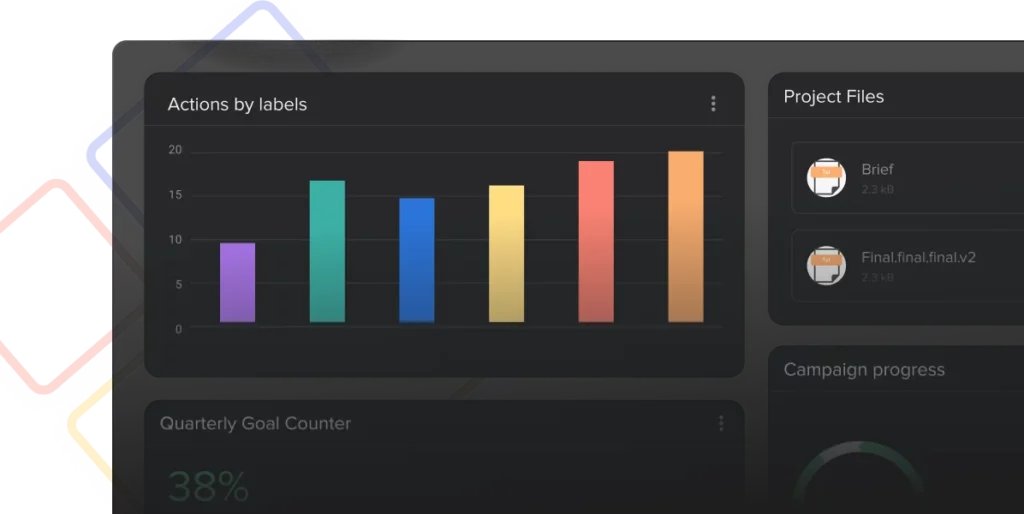
Every marketer loves an overview! A Birds Eye view of progress and data tracked neatly is invaluable for marketing teams for a few reasons. One, they make you and your team look good. Look at all of the work you’re getting done! Two, they’re easy to share and export from Hive directly.
Customizable dashboards also bring all key metrics—campaign status, asset approvals, budget tracking, and upcoming deadlines—into one visual, real-time view. You don’t have to keep updating slides or emails or another stale source of information. Whether you’re reporting to a CMO, briefing a client, or tracking your own workload, dashboards cut through the noise and make it easy to spot bottlenecks before they derail delivery.
ROI & Benchmarks
Why Marketing Teams Can’t Afford to Skip Specialized PM Tools
Time is money—especially in marketing. Teams using campaign-specific software report faster turnaround and higher throughput. But when it comes to snapshot numbers, Hive delivers compelling, marketing-centered results that really stand out.
Marketing teams leveraging Hive —with chat, task management, proofing, and AI—can cut project turnaround time by up to 28%, while also reducing tool costs by approximately 40%. That’s not just incremental; it’s the difference between reactive firefighting and proactive campaign execution.
Hive users are also seeing time-savings in broader workflow contexts: for example, McKinney Health reported a whopping 180 hours saved in just one month after deploying Hive to streamline complex workflows and approvals.
These efficiency gains translate into powerful ROI drivers for marketing teams:
- Faster campaign launches: With 28% shorter turnaround, project timelines shrink radically—meaning more campaigns delivered within the same timeframes or fewer resources needed per campaign.
- Tool consolidation savings: A 40% cut in tool costs reflects fewer subscriptions, less integration overhead, and lower platform sprawl—enabling budget reallocation to creative or media spend.
- Productivity gains: Saving 180 hours in just 30 days means roughly one full-time employee freed up for strategic or expansion work—without adding headcount.
Let’s put it in perspective: A mid-sized marketing team spending $60,000 per year on tools could save $24,000 annually, just in software consolidation. Add the 28% faster workflows—say shortening an average campaign from 10 to 7 days—and that’s not only faster go-to-market, but more campaigns per quarter, higher ROI per campaign, and potentially higher revenue contributions.
Hive vs Other Options on the Market
Why is Hive the right answer for your marketing team? It’s purpose built. We guarantee that your marketing workflows can flow through Hive and connect to the other parts of your business seamlessly.
No other project management tool has been built with these specific workflows in mind. Proofing in other tools is often fragmented or limited – you cannot proof the types of documents you’d need to, clients can’t view progress, or external users can’t check in on work. That isn’t productive for marketing teams.
Hive also has campaign-ready automations that are built with marketers in mind. Custom workflows that bring information from your file store systems, email, and other sources directly into Hive – and yes, it’s as great as it sounds. Our integrations can help your team consolidate and cut costs as well. You don’t need 7 tools when 1 can do the job.
Additionally, if you want to check out our comparisons with other project management tools at a high level, visit our compare page here.
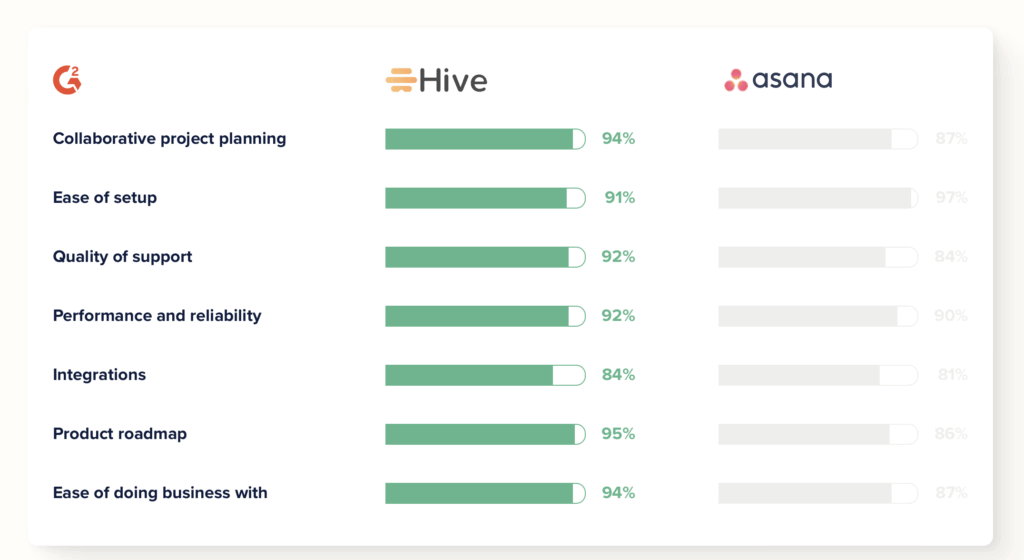
Here’s a more detailed breakdown of some of the most used marketing project management softwares, including Hive:
1. Hive
Hive is an all-in-one project management and collaboration platform built to help marketing teams move faster. It combines task tracking, campaign dashboards, proofing and approvals, client portals, chat, and automation in a single workspace—eliminating the need to juggle multiple tools. Hive supports every stage of a marketing project, from brainstorming and content creation to launch and reporting, with flexible views like Gantt, Kanban, calendar, and table.
Marketing teams using Hive report up to 28% faster project turnaround times and 40% lower tool costs through platform consolidation. Features like built-in asset proofing, branded client portals, and real-time dashboards make it easy to collaborate with internal teams, agencies, and clients without email overload or version confusion. Whether you’re running multi-channel campaigns, managing creative approvals, or tracking ROI, Hive gives you a central hub to keep work visible, deadlines clear, and teams aligned.
2. Asana

Asana is one of the most recognizable names in project management, offering a clean, intuitive interface and multiple ways to organize work—list, board, timeline, and calendar views. For marketing teams, Asana’s strengths include campaign timeline tracking, recurring task automation, and integrations with tools like Slack, Google Drive, and Adobe Creative Cloud.
These make it easier to manage content calendars, event timelines, and multi-step campaigns. However, it lacks built-in creative proofing tools, meaning teams must rely on third-party apps for asset reviews. Client collaboration is possible, but not as seamless as dedicated client portal functionality.
3. Monday.com
Monday.com is known for its visually appealing, color-coded boards and an extensive library of templates, including some tailored for marketing workflows. Marketing teams can use it to manage campaign pipelines, track creative production stages, and centralize communication.
Its strong automation features help with repetitive tasks, such as updating statuses or notifying stakeholders when milestones are hit. That said, advanced marketing-specific needs—like asset proofing, client approvals, or unified campaign dashboards—often require add-ons or custom builds, which can increase complexity and costs.
4. ClickUp

ClickUp’s main advantage is flexibility: it offers a wide range of views (Gantt, list, board, calendar, workload) and nearly unlimited customization. Marketing teams can build out campaign workflows, track budgets, and assign granular permissions. ClickUp also includes built-in docs and whiteboards for brainstorming, plus goal tracking for performance metrics.
However, the sheer volume of features can overwhelm new users, and getting a streamlined marketing-specific setup often takes significant configuration. Proofing and client collaboration aren’t as integrated as in marketing-focused platforms – you have to rely on outside tools to get the work done.
5. Trello
Trello is beloved for its simplicity. Its Kanban-style boards are ideal for visualizing campaign stages, such as “Ideas,” “In Progress,” and “Published.” Marketing teams appreciate its ease of onboarding, drag-and-drop interface, and integration with tools like Google Drive and Slack. Trello’s power-ups (add-ons) can extend functionality for calendars, dashboards, and automation.
However, for larger teams or complex, multi-channel campaigns, Trello’s lightweight approach can become limiting—especially when it comes to in-platform reporting, proofing, or managing multiple campaigns at once. If you’re looking for something simple for a small marketing team, Trello could be a good place to start.
6. Smartsheet

Smartsheet brings spreadsheet-style familiarity to project management, making it a good fit for teams that live in Excel. For marketing, it can manage detailed campaign budgets, schedules, and resource allocations, and its automation tools can handle reminders and status updates.
Smartsheet also supports form submissions, which can help with intake processes like creative briefs and other essential marketing intake processes. While powerful for data-heavy planning, it can feel rigid for creative collaboration and lacks natively integrated proofing or client-friendly interfaces.
7. Wrike
Wrike offers a robust, enterprise-grade project management platform with strong reporting and workload management features. For marketing teams, Wrike provides campaign planning templates, proofing tools, and the ability to manage requests through custom forms.
It’s particularly strong for teams that require advanced analytics and integration with enterprise systems like Salesforce or Adobe. However, Wrike’s complexity and pricing can be barriers for smaller marketing teams, and some users find its interface less intuitive than more visual, marketer-friendly tools.
Don’t Know Where To Start? Templates

If you’re unsure about how to get started with your marketing team in Hive…we’ve done the work for you. Here are several templates that you can apply directly to your Hive workspace that can help get your team started right now.
Marketing Templates from Hive
1. Marketing Plan Template
A comprehensive framework ideal for designing multi-channel strategies, including social campaigns, product launches, market research, and more. Start with a clear roadmap and customize as needed.
2. Content Calendar Template
Perfect for planning blogs, social posts, email campaigns, and editorial content—this template keeps your team organized and aligned with publication schedules and performance tracking.
3. Paid Marketing Campaign Template
Designed to manage budget tracking, deliverables, influencers, and campaign milestones—all within a customizable, timeline-driven layout.
4. PR Campaign Template
Focuses on managing outreach and public relations efforts, tracking tasks through stages such as “Pitched” and “Coverage Secured.”
How to Access These Templates
- Log into your Hive workspace.
- Click the blue “?” in the upper‑right corner, and select “Template Library”.
- Browse or search for any of the templates above, or apply them directly to your projects and dashboards for instant structure and setup.
Hive Marketing Case Studies
We’ve helped teams all over the world get their marketing workflows situated. Here are a few of our favorites:
Starbucks
The concept design studio at Starbucks defines the design palate for all 13,000+ Starbucks locations in the Americas and is integral to the process of opening new stores. Before using Hive, the team was managing all their projects in Excel, but it wasn’t scalable and it was prone to error.
It was also completely separate from their files in Dropbox and their chat conversations in Outlook. With the team divided between New York and Seattle and their work spread out among so many tools, it was impossible to make sure everything was on track.
They wanted to a more efficient way to see what everyone was working on and easily set priorities. They also wanted a solution that could accommodate many different working styles, integrate with Dropbox, and maintain a shared record of information.
Since switching to Hive, the speed of designing new stores has increased significantly. Every project – from vetting specific items to catalog management – is managed in Hive. At a glance, anyone can easily see which tasks are unstarted, in progress, under review, or completed.
“Starbucks couldn’t roll new stores out so quickly without Hive. We have eliminated miscommunication, saved hours of unnecessary meetings, and achieved full transparency across all our projects,” says Brian Collins, Interior Concepts Design Manager.
Egglands Best
Egglands used Hive to manage a redesign and branding initiative for their egg cartons. They used Hive and proofing/approvals to streamline their workflows and processes, saving hours and thousands of dollars.
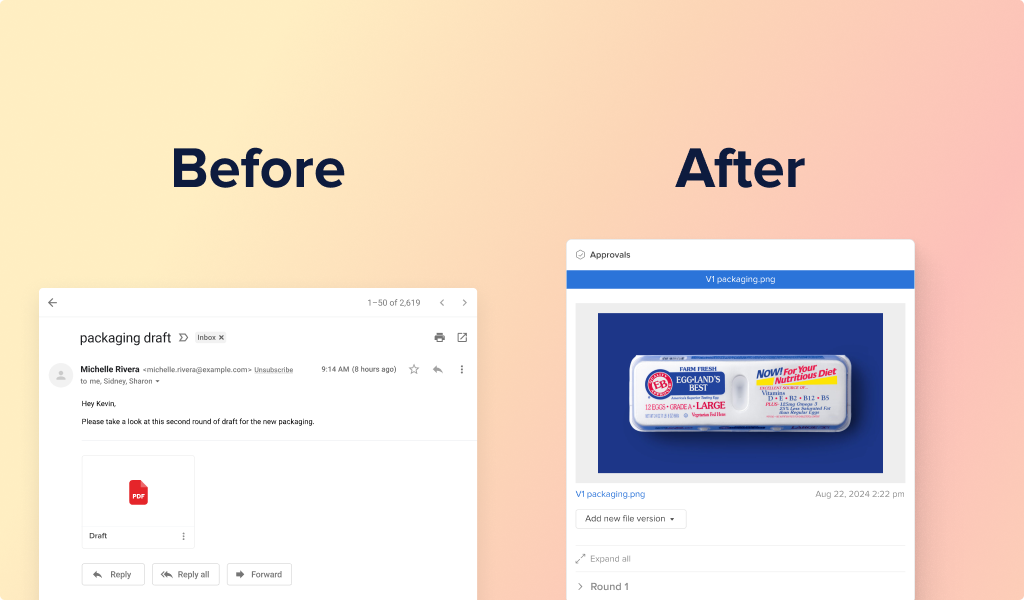
The automation of their proofing process helped them efficiently transition their packaging over to their modern and updated designs, their head of digital marketing even said “Having everything in one place has definitely helped us stay on top of things and freed the team up to focus on creating and engaging consumers to try, buy, and love Eggland’s Best eggs.”
Point Loma University
Their goal with Hive was to consolidate a high volume of projects and efficient management of a team of designers, marketers, and seasonal interns. The marketing team operates as PLNU’s internal strategy agency, researching and making recommendations to stakeholders on how to achieve desired outcomes.

With Hive, they used the Proofing and Approvals app to move marketing elements through to final approval also supports the team’s goals around clear communications and transparent workflows.
Wrapping Up: The Right Tool Makes All the Difference
Marketing teams today can’t afford to waste time switching between tools, chasing approvals, or guessing where campaigns stand. The right project management software doesn’t just organize tasks—it gives your team the visibility, control, and collaboration tools needed to deliver impactful campaigns on time, every time.
While Asana, Monday.com, ClickUp, Trello, Smartsheet, and Wrike each have their strengths, Hive brings it all together in one intuitive platform purpose-built for marketers. With integrated dashboards, client portals, creative proofing, and campaign-ready templates, Hive streamlines workflows from kickoff to reporting.
If your goal is to launch more campaigns, faster, with fewer headaches, now is the time to try a tool that’s designed around the way marketing teams actually work.
Ready to see the difference?
Start your free trial of Hive today and explore our Marketing Template Library to kickstart your next campaign. Your future projects—and your team—will thank you.
